Financials R12 – Fixed Assets

Table of Contents
Setup Flow of Fixed Asset Setup 3
Oracle Assets Key Flexfields 4
Asset Category Key Flexfield 4
Setup Flow of Fixed Asset Setup
- Sets of Books 🡪 Required
- Units of Measure Classes
- Units of Measure Categories
- Employees
- Descriptive Flexfields
- Account Generator
- Journal Entry Sources
- Journal Entry Categories
- Numbering
- Suppliers
- Asset Key Flexfield 🡪 Required
- Asset Category Flexfield 🡪 Required
- Location Flexfield 🡪 Required
- System Controls 🡪 Required
- Locations
- Asset Keys
- Quick Codes
- Fiscal Years 🡪 Required
- Calendars 🡪 Required
- Security
- Book Controls 🡪 Required
- Depreciation Methods
- Depreciation Ceilings
- Investment Tax Credits
- Prorate Retire Conventions 🡪 Required
- Price Indexes
- Asset Categories 🡪 Required
- Distribution Sets
- Leases
- Warranties
- Profile Options
- Insurance
Oracle Assets Key Flexfields
- Asset Category Key Flexfield
- Asset Location Key Flexfield
- Asset Key Key Flexfield
Setting Up Key Flexfields
- Define Value Sets
- Define Flexfield Segments
- Define Values for Each Segment
Asset Category Key Flexfield
| Purpose | To Group Assets By Financial Information |
| Max. Number of Segments | 7 |
| Max. Width | 30 spaces |
| Segment Qualifier | 1 segment must be designated Major Segment |
| Table Name | FA_CATEGORIES |
| Use Dynamic Insert | No |
| Unique ID Column | CATEGORY_ID |
Specifying System Controls
Oracle Asset System Controls
- Enterprise Name
- Flexfield Structures
- Oldest Date Placed in Service
- Automatic Asset Numbering
(N) Setup 🡪 Financials 🡪 Flexfields 🡪 Key 🡪 Segments
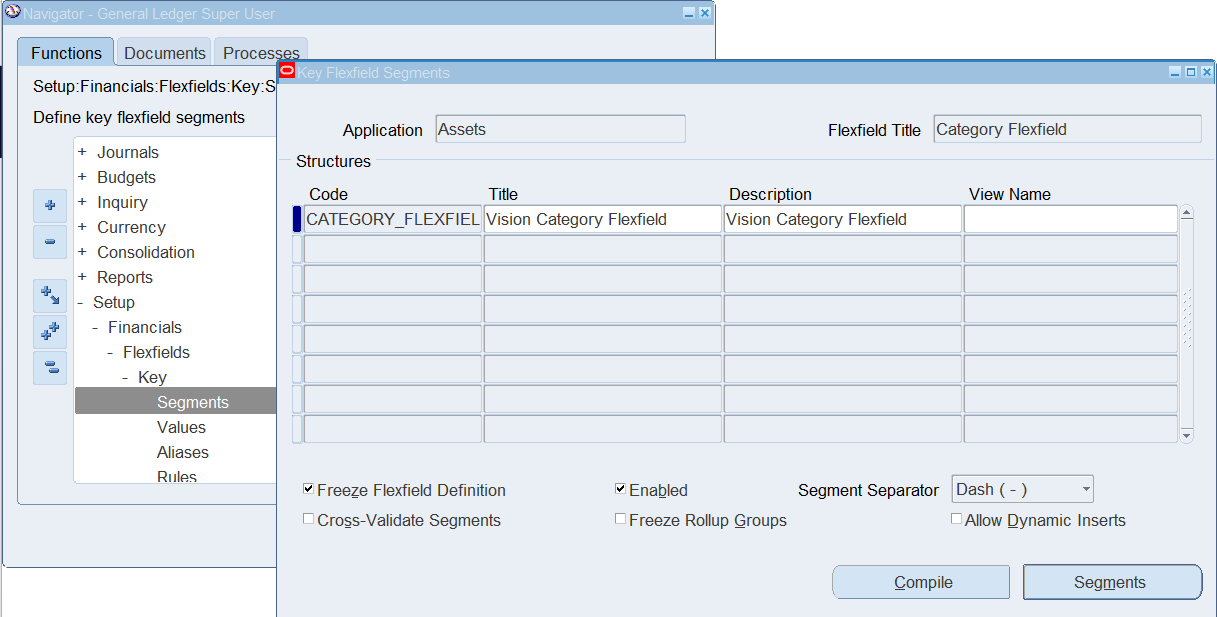
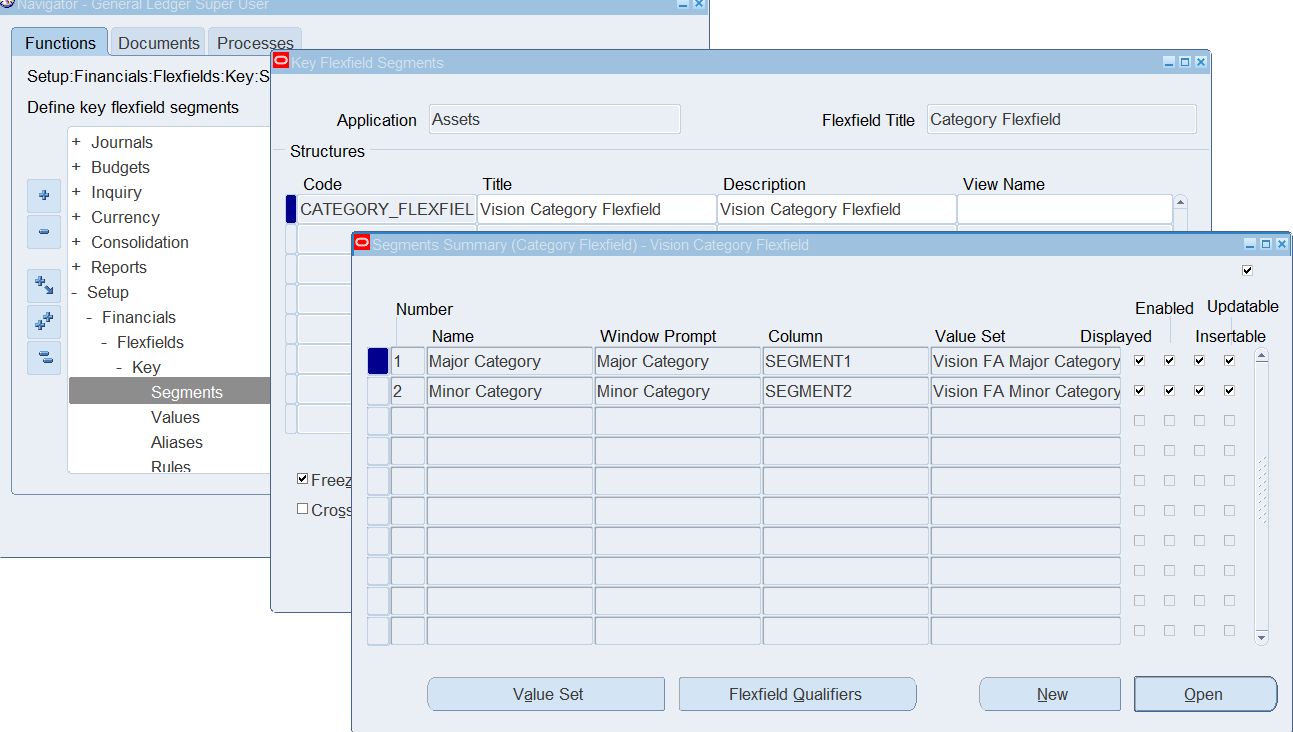
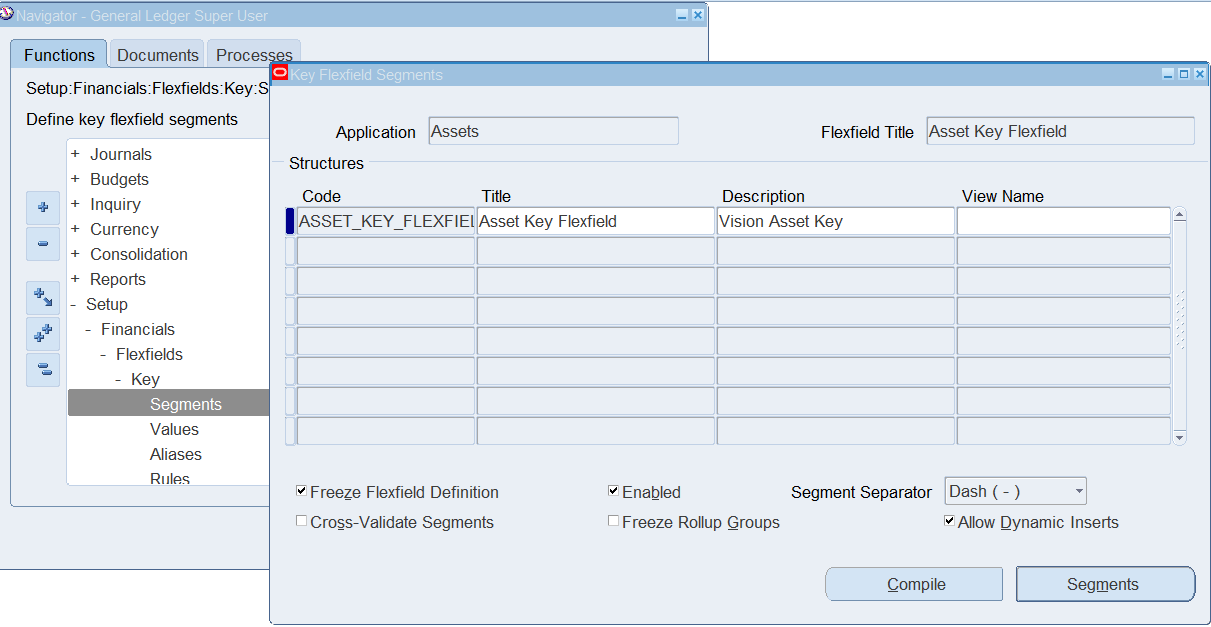
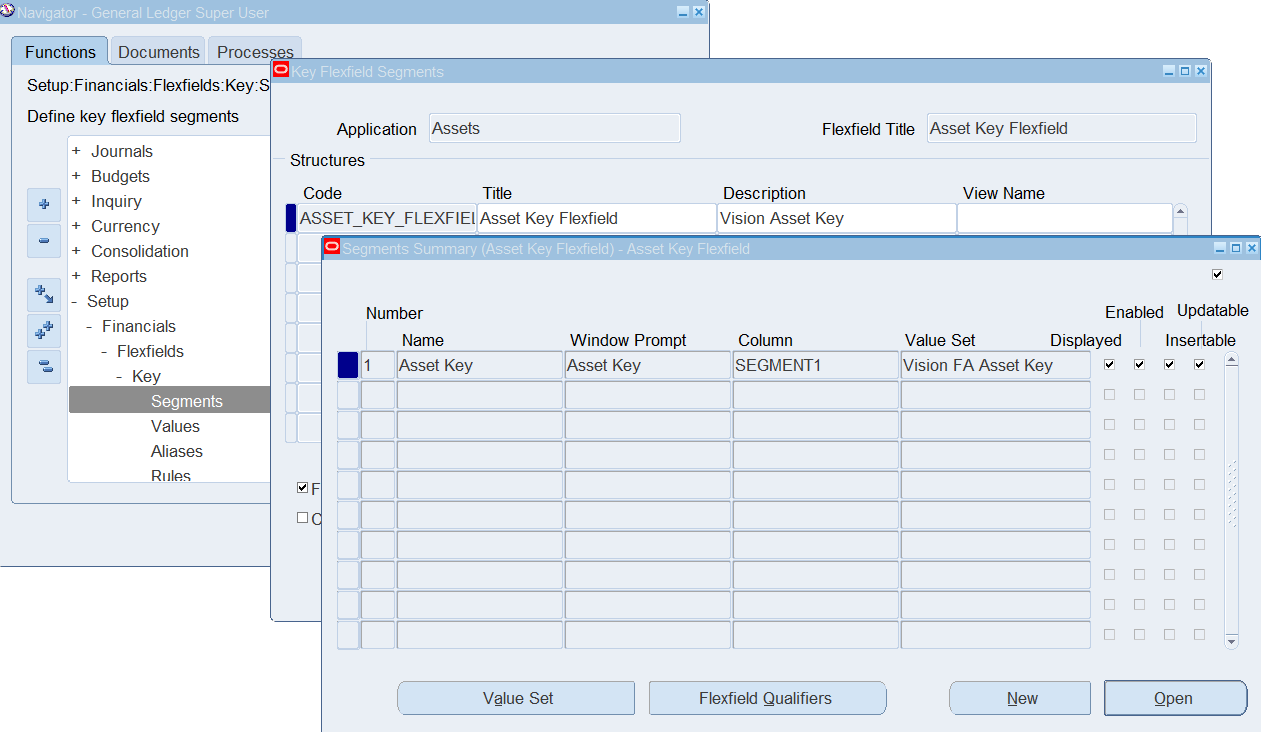
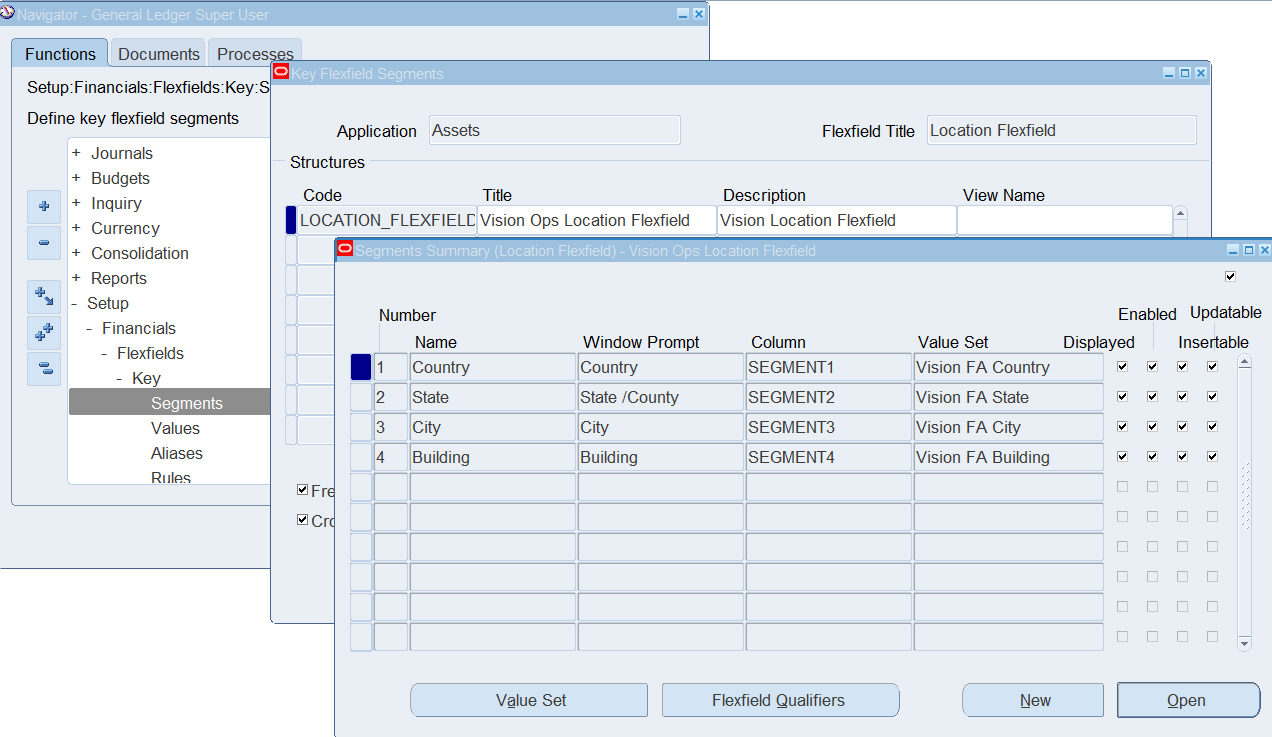
CAPITAL PROJECT PROCESS
=======================
1. Project Definition
Project Type
Project Template
2. Task Definition
3. Key Member (Project Manager)
4. Changed Project Status to Active
5. Cost Collections
OTL/ Timesheet
PO
AP Invoices
Allocations
Burdening
Cross Charges
Pre-approved Exp Batches
6. Distribute Programs
7. Generate Cost Accounting Events Program
8. Create Accounting
9. Define Asset
10.Assign Asset @ Project Level / Task Level
11.Capitalization window
12.Change project Asset Type –> Estimated to As-Built
13.Key Required Asset Data
14.Generate Asset Lines
15.Review Asset Lines
16.Interface Asset Lines to Fixed Assets
17.Run Tie-Back Program
Define Calendar
- Fiscal Calendar
- Calendar Periods
- Prorate Conventions
Setup Fiscal Year
(N) Setup 🡪 Asset System 🡪 Fiscal Years
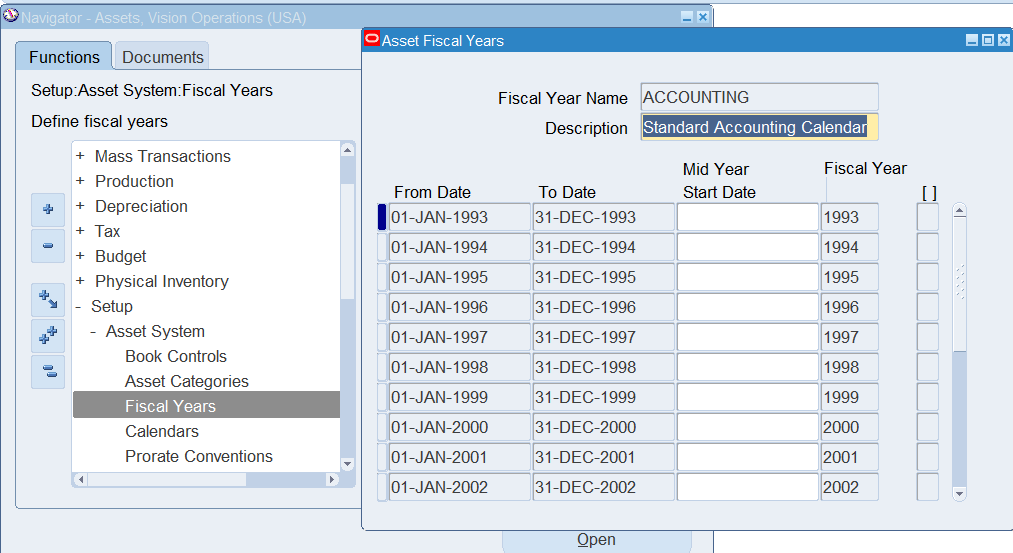
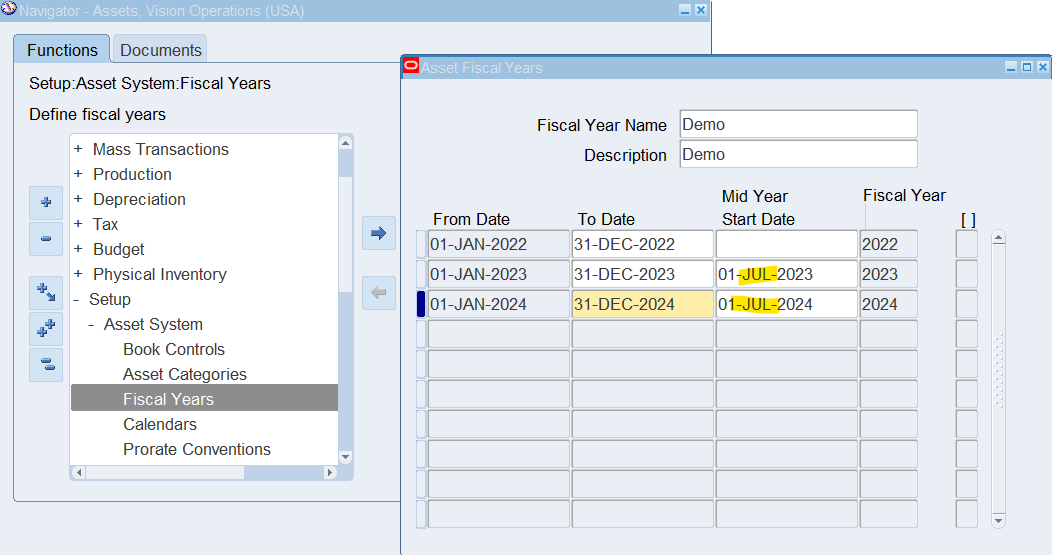
Note: Mid Year Start Date is optional
Calendar Periods
You can setup as many calendars as you need. Each book you setup requires a depreciation calendar and a prorate calendar. The depreciation calendar determines the number of accounting periods in a fiscal year, and the prorate calendar determines the number of prorate periods in a fiscal year. You can also use one calendar for multiple depreciation books, and as both the depreciation and prorate calendar for a book.
Your corporate books can share the same calendar. A tax book can have a different calendar than its associated corporate book. The calendar for a tax book must use the same fiscal year name as the calendar for the associated tax book.
The depreciation program uses the prorate calendar to determine the prorate period which is used to choose the depreciation rate. The depreciation program uses the depreciation calendar and divides depreciation flag to determine what fraction of the annual depreciation expense to take each period. For example, if you have a quarterly depreciation calendar, Oracle Assets calculates one-fourth of the annual depreciation each time you run depreciation.
You must initially set up all calendar periods from the period corresponding to the oldest date placed in service to the current period. You must set up at least one period before the current period. At the end of each fiscal year, Oracle Assets automatically sets up the periods for the next fiscal year.
Attention: If you use this depreciation calendar in a depreciation book from which you create journal entries for your general ledger, you must make the period names identical to the periods you have set up in your general ledger.
You can define your calendar however you want. For example, to define a 4-4-5 calendar, set up your fiscal years, depreciation calendar, and prorate calendar with different start and end dates, and fill in the uneven periods. To divide annual depreciation proportionately according to the number of days in each period, enter By Days in the Divide Depreciation field in the Book Controls window.
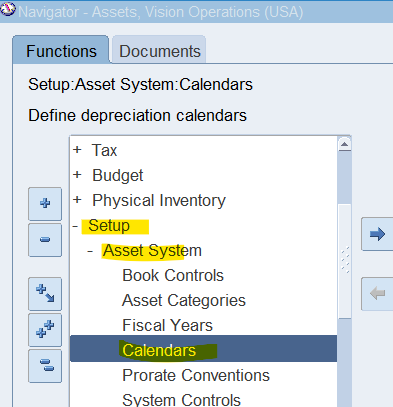

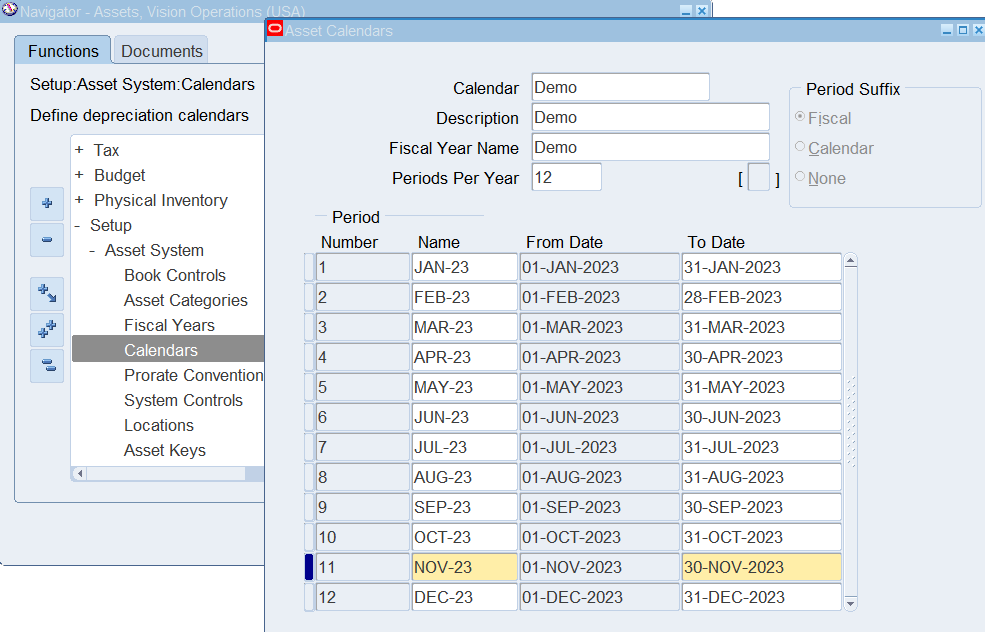
Prorate Conventions
You can set up or review prorate and retirement conventions in the Prorate Conventions window.
You must initially set up all your prorate conventions from the convention period corresponding to the oldest date placed in service through the end of the current fiscal year. At the end of each fiscal year, Oracle Assets automatically sets up your prorate conventions for the next fiscal year.
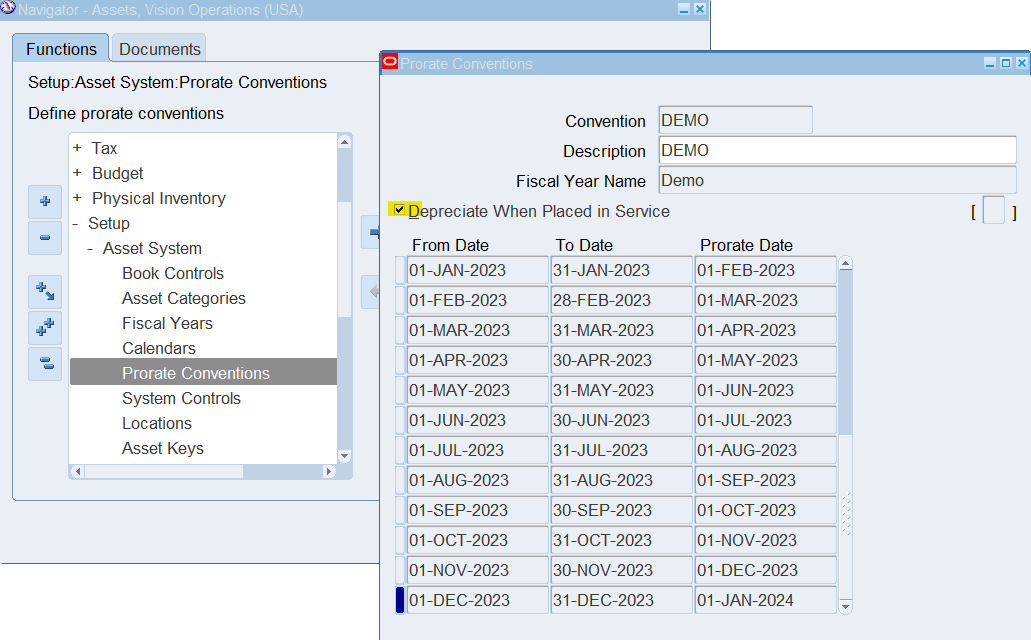
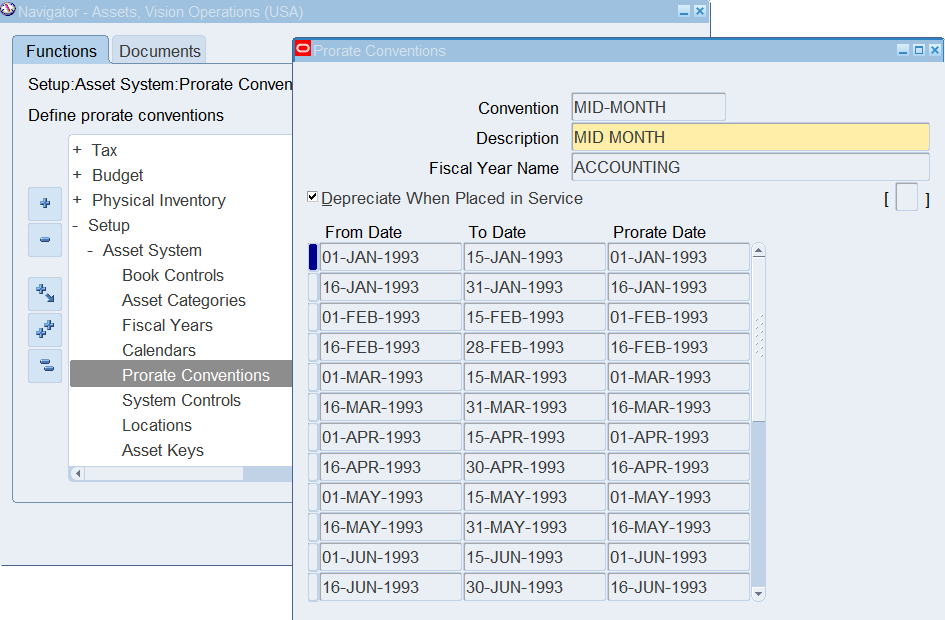
This option determines over how many periods to spread the annual depreciation amount. For assets that use a calculated (straight-line) method, Oracle Assets ignores this option and always starts taking depreciation in the accounting period that corresponds to the prorate date.
Define Book Controls
Defining Depreciation Books
You can define corporate, tax, and budget depreciation books. You must set up your depreciation books before you can add assets to them. You can set up multiple corporate books that create journal entries for different ledger, or to the same ledger. In either case, you must both run depreciation and create journal entries for each depreciation book. For each corporate book, you can set up multiple tax and budget books that are associated with it.
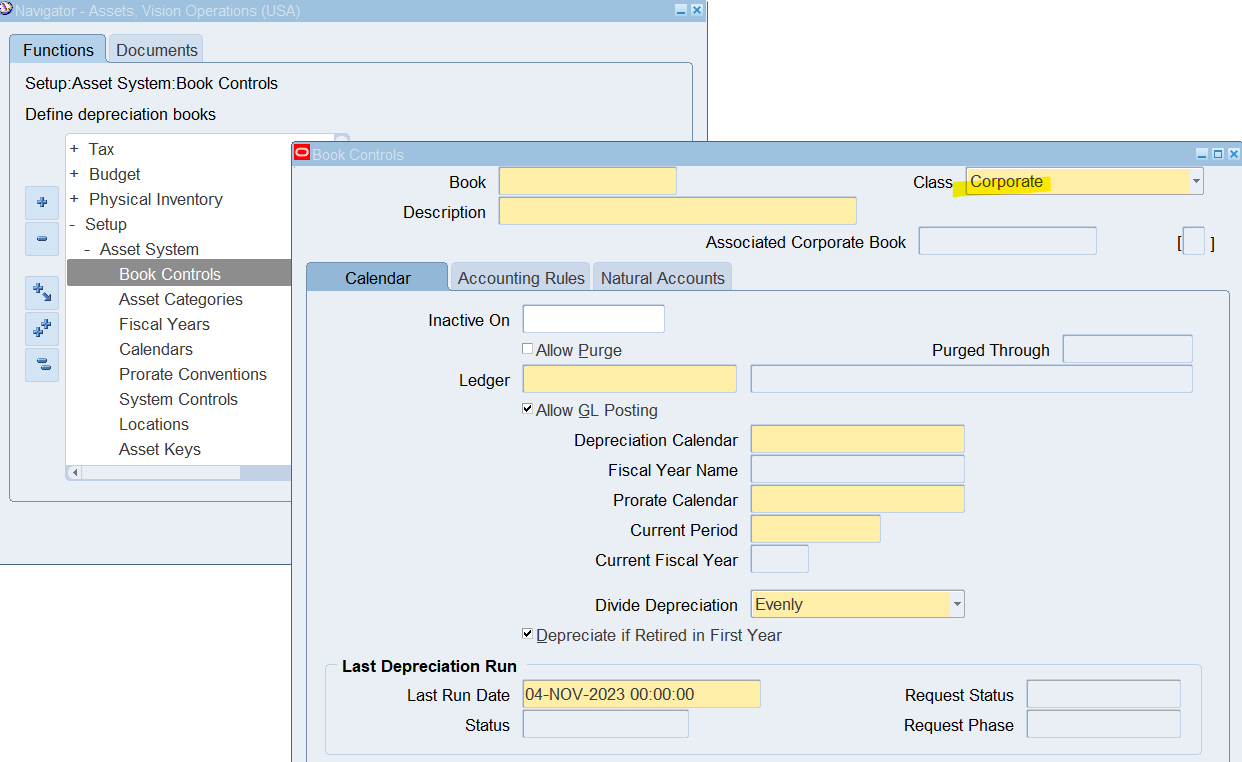

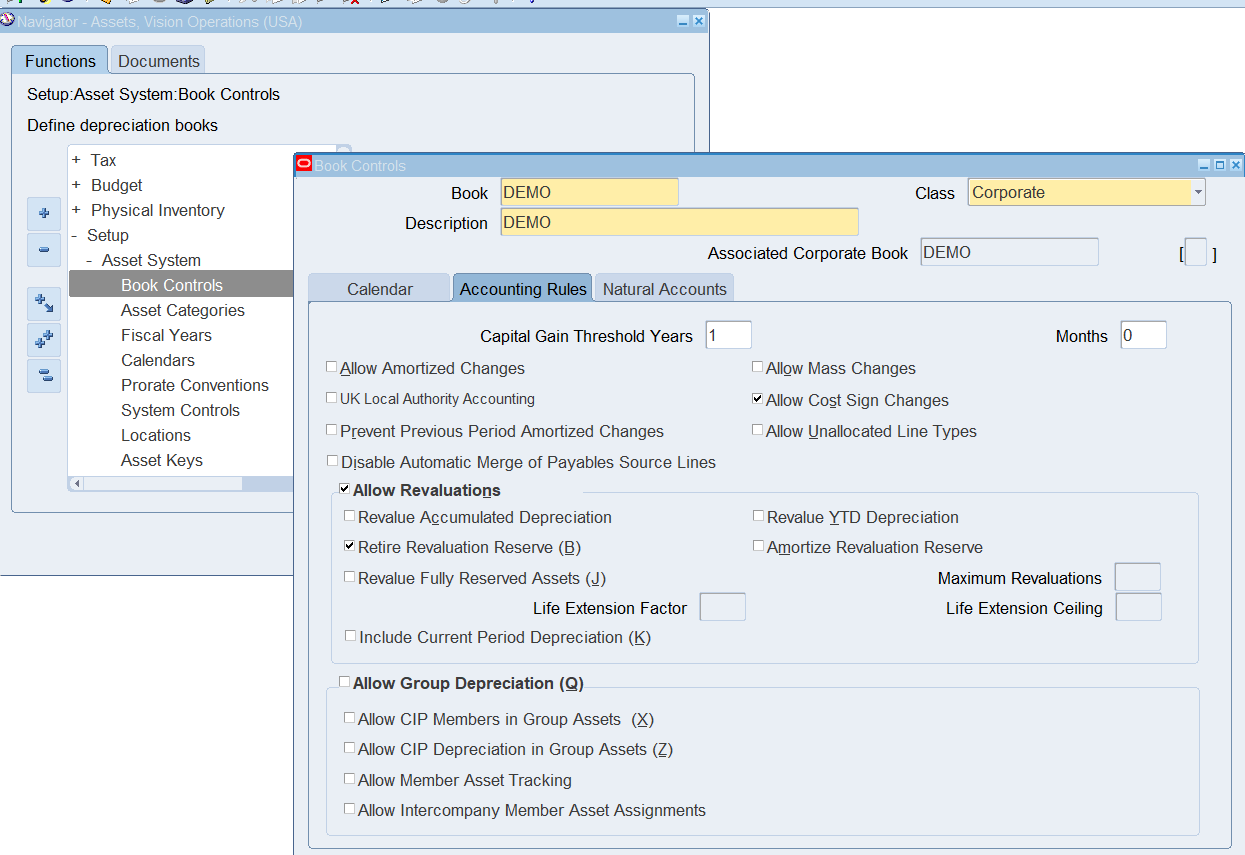
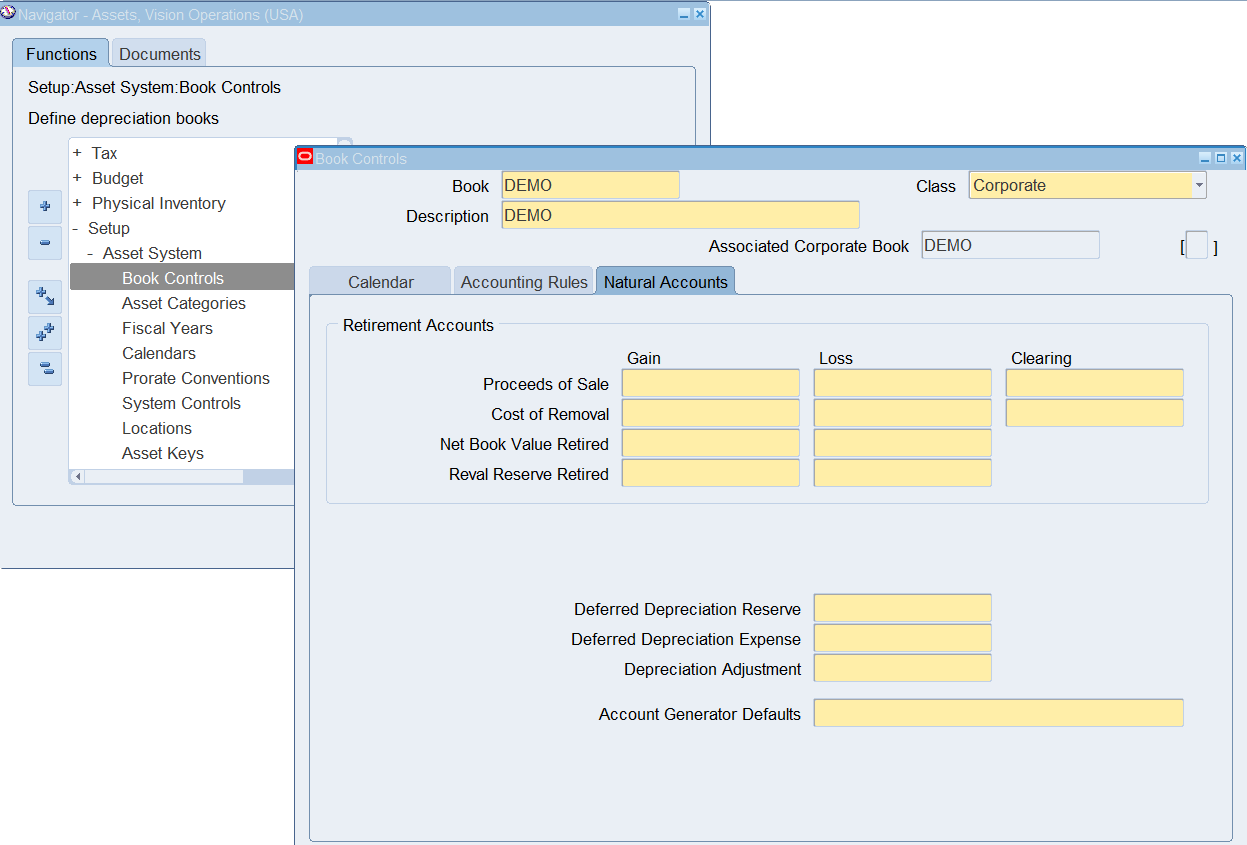
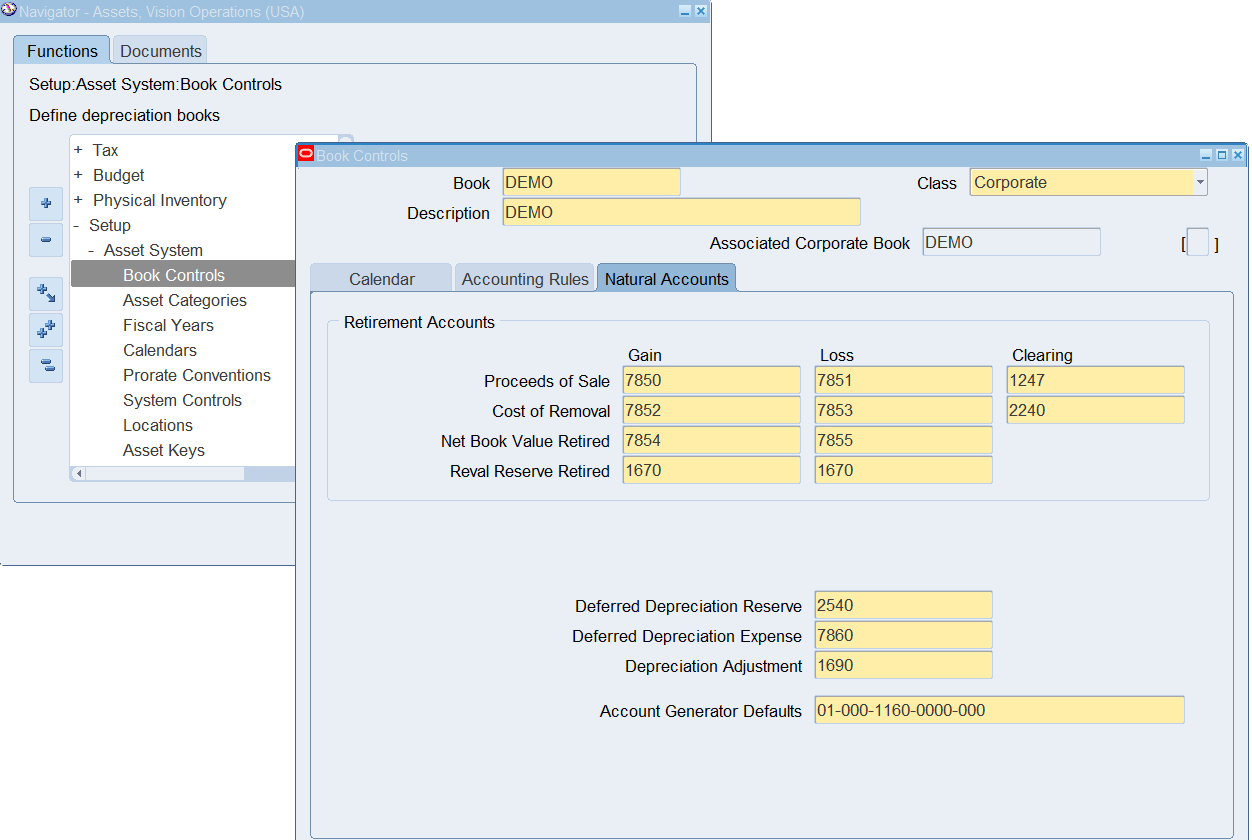
Entering Natural Accounts for a Book
- In the Book Controls window, choose the Natural Accounts tabbed region.
- Enter Retirement Accounts.
You can set up your gain and loss accounts so that Oracle Assets creates individual journal entries for each component of the gain/loss amount to separate accounts, or to a single account for the net gain or loss.
- Enter Deferred Depreciation Reserve and Deferred Depreciation Expense accounts.
- Enter the general ledger account that you want to use as an offset account for the entry against accumulated depreciation when you perform reserve adjustments.
- Enter the Account Generator default segment values for this book’s journal entries.
By default, Oracle Assets creates journal entries without cost center level detail for all accounts except the depreciation expense account. Using the default assignments, it creates journal entries using the balancing segment from the expense account in the Assignments window and the account segment from the asset category or book, depending on the account type. Oracle Assets uses the other segments from the default segment values you enter for the book in this field.
Defining Tax Book

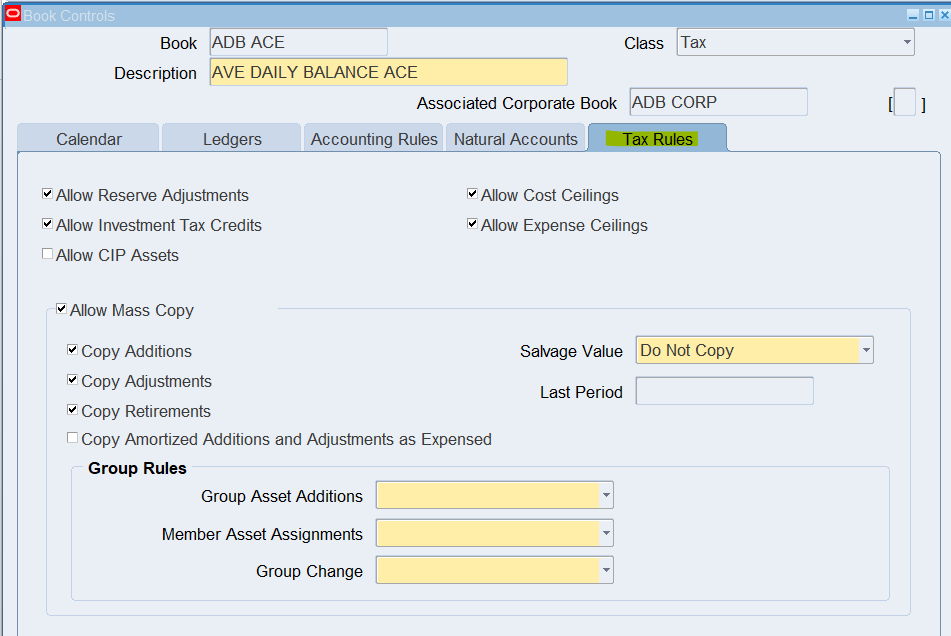
System Controls
System Control is used to specify company name, asset numbering scheme, and key flexfield structures

Pre-Requisites for System control are Pre-Defined
- Define Category Flexfield
- Define Location Flexfield
c. Define Asset Key Flexfield
![]()
a. Category Flexfield
Oracle Assets uses the category flexfield to group your assets by financial information. You design your category flexfield to record the information you want. Then you group your assets by category and provide default information that is usually the same for assets in that category.
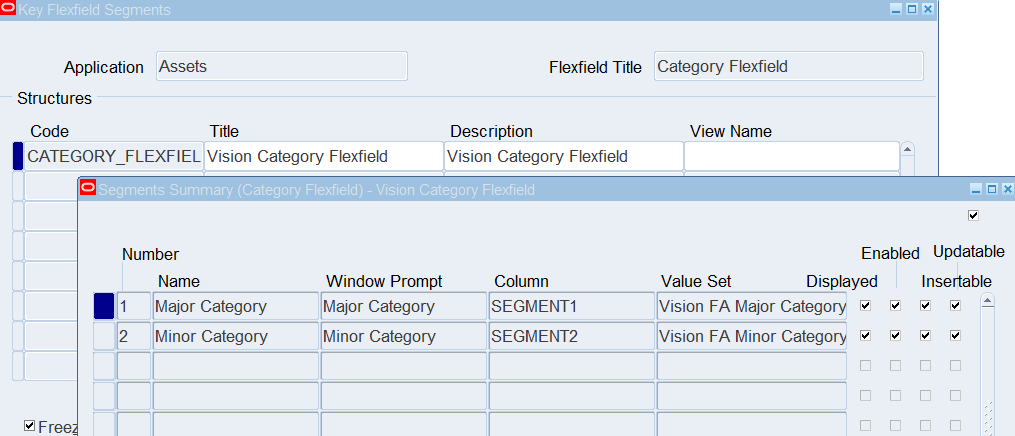
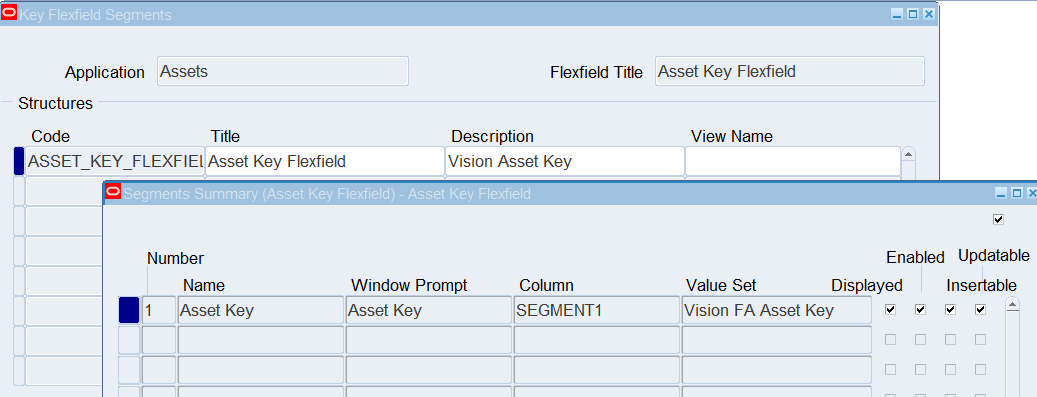
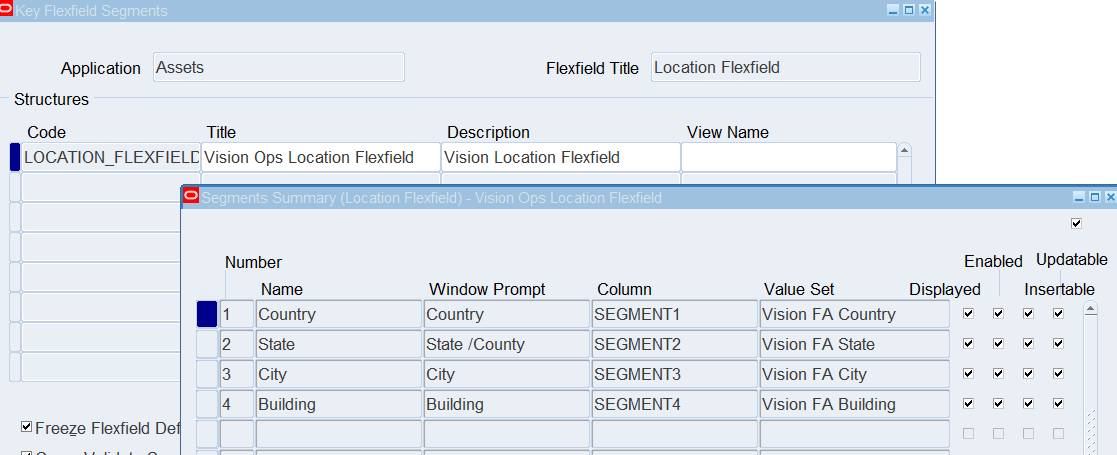
Category Structure
Consider the way you group your assets. Determine which assets share depreciation information such as prorate convention and depreciation method. You also need to decide how many levels (segments) your category structure needs. Decide which is the top level (major category segment).
You may want to set up your categories to match your chart of accounts. Each chart account defines a major category. You can define at least one subcategory segment to allow for distinctions within a major category.
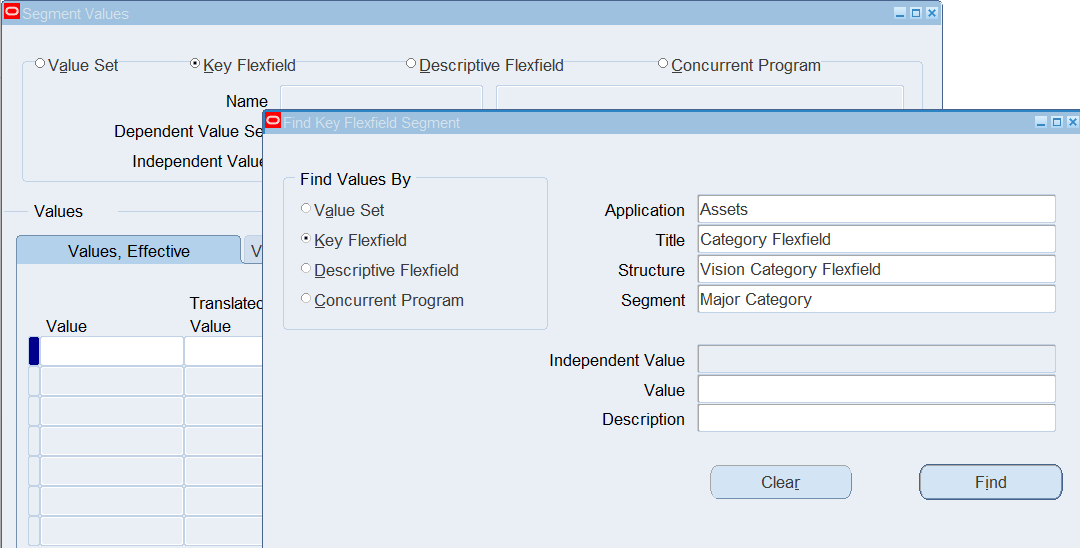
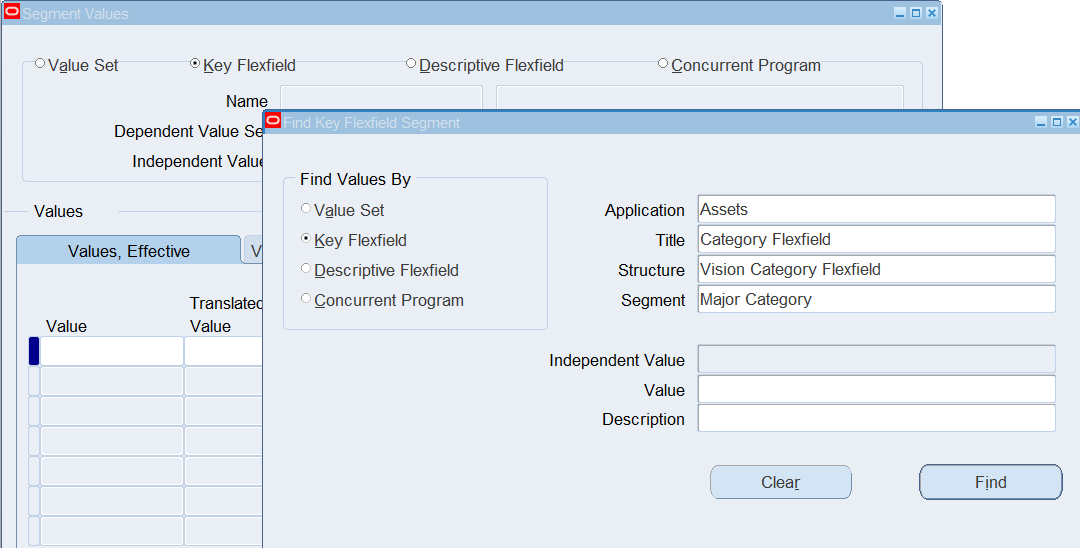
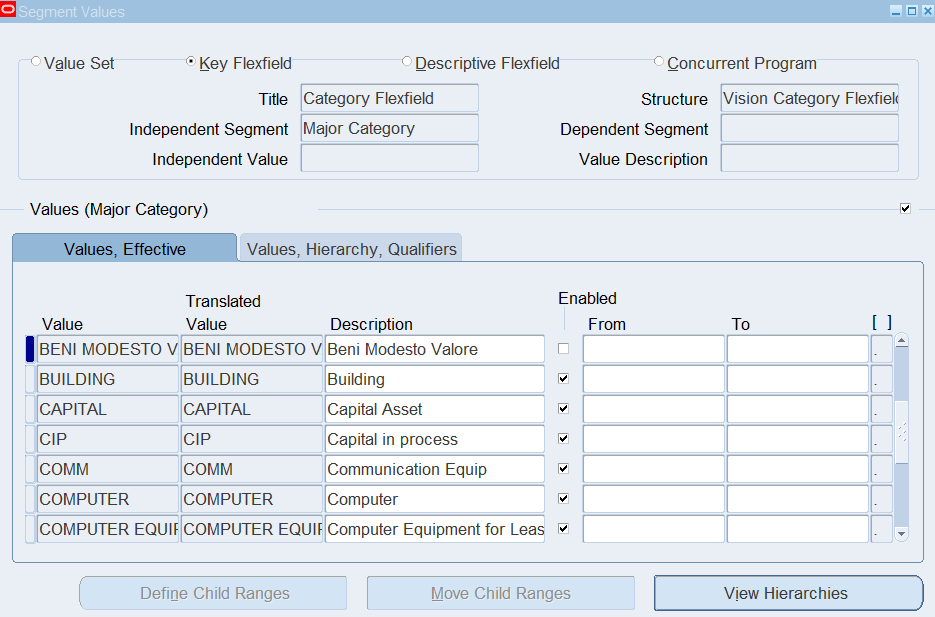
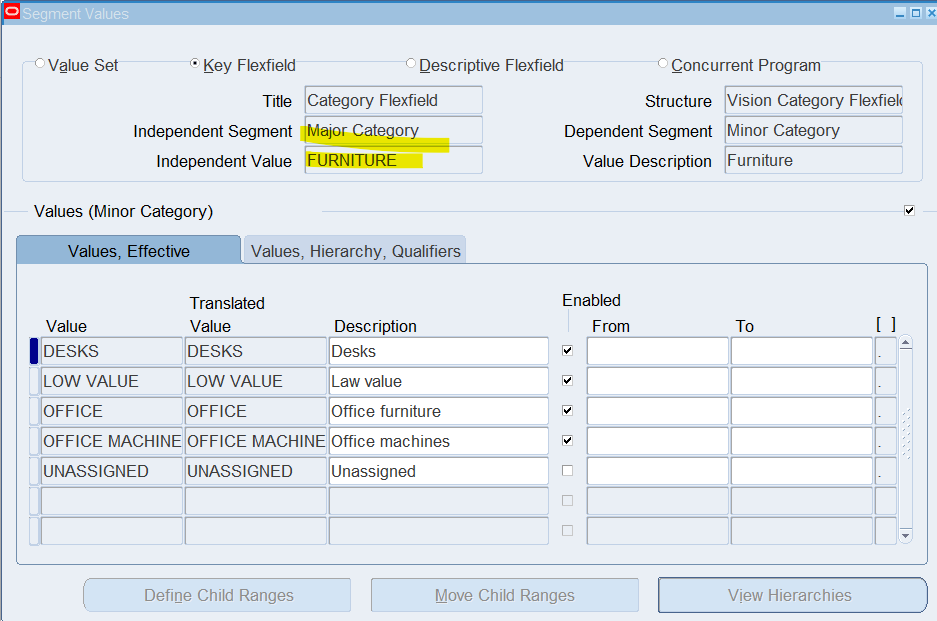
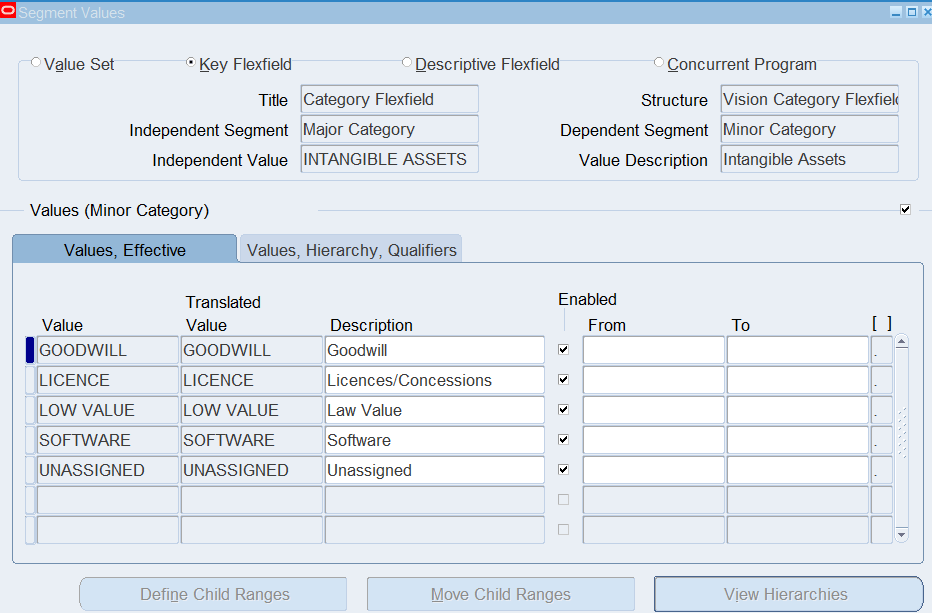

Defining Assets Categories
Category information is common for a group of assets. Oracle Assets defaults these depreciation rules when you add an asset, to help you add assets quickly. If the default does not apply, you can override many of the defaults for an individual asset in the Asset Details or Books windows. You set up default values for each category in each book. The default depreciation rules that you set up for a category also depend upon the date placed in service ranges you specify.
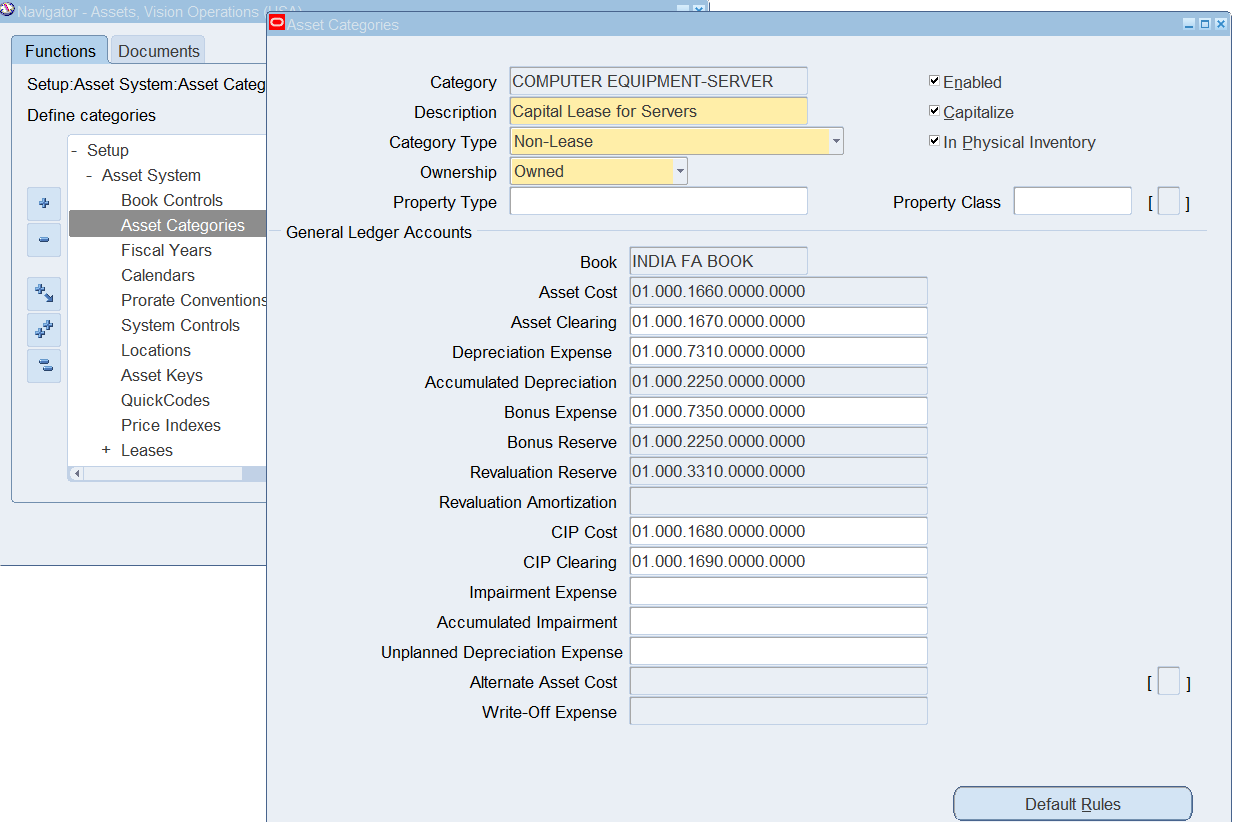
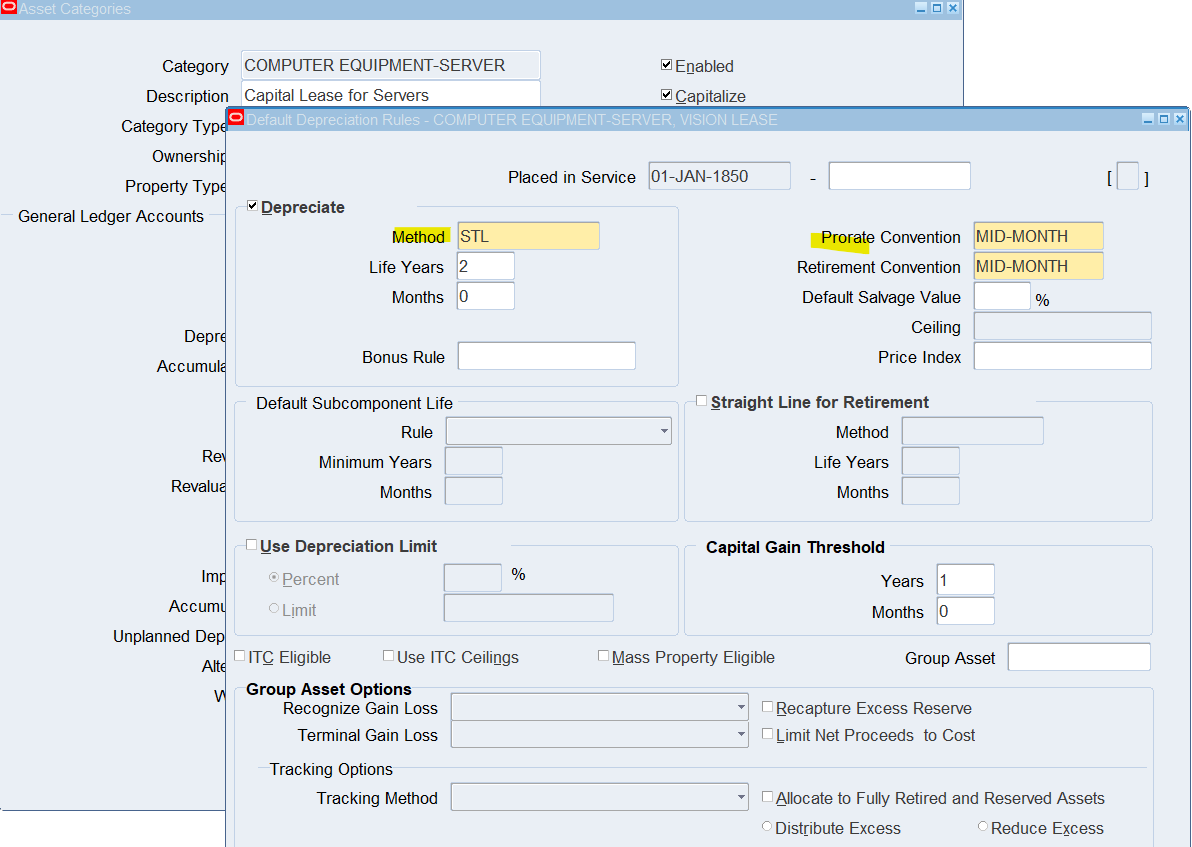
Assets Workbench
Use the Assets Workbench windows to add new assets to the system, and to perform transactions, such as retirements, adjustments, source line adjustments, and transfers.
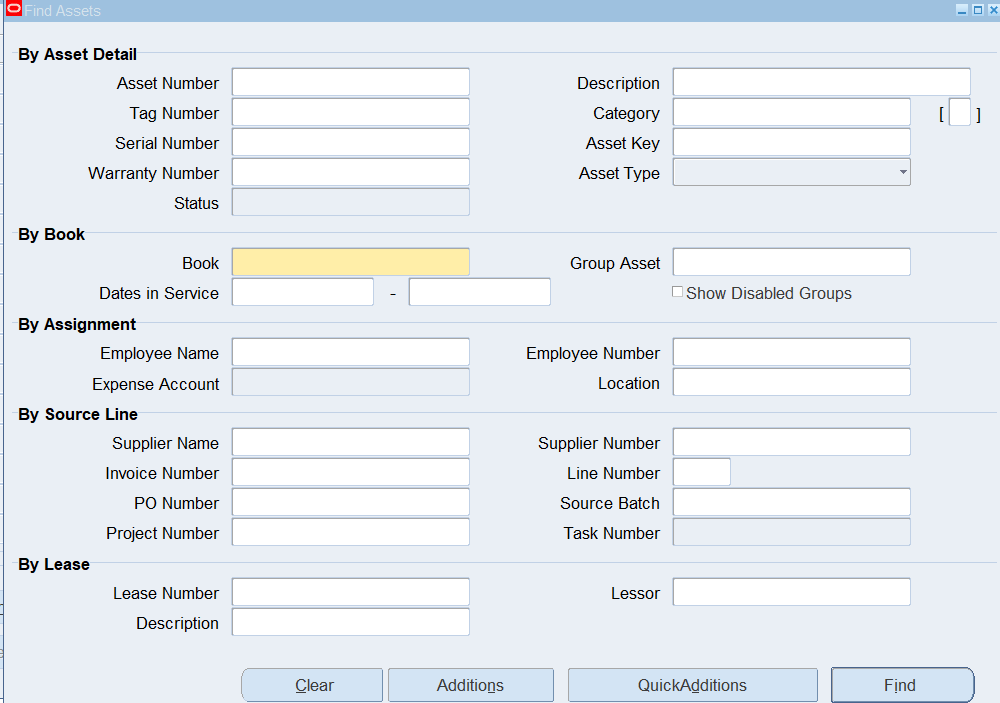
Asset Descriptive Details
This section describes selected fields on the Asset Details window.
Asset Number
An asset number uniquely identifies each asset. When you add an asset, you can enter the asset number, or leave the field blank to use automatic asset numbering. If you enter an asset number, it must be unique and not in the range of numbers reserved for automatic asset numbering. You can enter any number that is less than the number in the Starting Asset Number field in the System Controls window, or you can enter any non-numeric value.
Description
Use list of values to choose a standard description you defined in the QuickCodes window, or enter your own.
Tag Number
If you enter a tag number, it must be unique. A tag number uniquely identifies each asset. For example, use the tag number to track asset barcodes, if you use them.
Category
Oracle Assets defaults depreciation rules based on the category, book, and date placed in service. All assets in a category share the same asset cost accounts and depreciation accounts for each depreciation book.
Category Descriptive Flexfield
Descriptive flexfields allow you to collect and store additional information about your assets. For each asset category, you can set up a descriptive flexfield to prompt you for additional information based on the asset category you enter. For example, you might want to track the license number for automobiles, but the square footage for buildings. When you specify a category for a new asset, you can enter your information in a descriptive flexfield.
Asset Key
The asset key allows you to group assets or identify groups of assets quickly. It does not have financial impact; rather it can be used to track a group of assets in a different way than the asset category. For example, use an asset key to group assets by project.
Asset Type
Valid asset types are:
Capitalized: Assets included on the company balance sheet. Capitalized assets usually depreciate. Charged to an asset cost clearing account.
CIP (Construction-In-Process): Unfinished assets being built, not yet in use and not yet depreciating. Once you capitalize a CIP asset, Oracle Assets begins depreciating it. Charged to a construction-in-process clearing account.
Expensed: Items that do NOT depreciate; the entire cost is charged in a single period to an expense account. Oracle Assets tracks expensed items, but do not create journal entries for them. Oracle Assets does not depreciate expensed assets, even if the Depreciate check box in the Books and Mass Additions Prepare windows is checked for that asset.
Group: A group asset is a collection of member assets. You can add member assets to a group asset, transfer assets out, or between groups assets. Group asset cost is the sum of all the associated member assets costs. A group may contain many individual assets that were placed into service in different years, but share one depreciation account maintained for the group. Group asset depreciation, known as group depreciation, is computed and stored at the group level.
Units
The number of units represents the number of components included as part of an asset. Use units to group together identical assets. For example, you might add an asset that is composed of ten separate but identical chairs. If you are adding an asset, accept the default value of one, or enter a different number of units.
Parent Asset
You can separately track and manage detachable asset components, while still automatically grouping them to their parent asset. For example, a monitor can be tracked as a subcomponent of its parent asset, a computer. You can specify a rule in the Asset Categories window by which Oracle Assets defaults the life for a subcomponent asset based on the category and the parent asset life.
Enter the parent asset to which your asset belongs if you are adding a subcomponent asset. The parent asset must be in the same corporate book. If you are adding a leasehold improvement, enter the asset number of the leased asset. To properly default the subcomponent life, add the parent asset before the subcomponent.
You must set up the depreciation method for the subcomponent asset life before you can use the method for that life. If your subcomponent asset uses a depreciation method of type Calculated, Oracle Assets sets up the depreciation method for you. If the depreciation method is not Calculated and if it is not already set up for the subcomponent life rule default, Oracle Assets uses the asset category default life.
Oracle Assets does not automatically perform the same transaction on a subcomponent asset when you perform it on the parent asset. Use the Parent Asset Transactions Report to review the transactions that you have performed on parent assets during a period.
Warranty Number
You can set up and track manufacturer and supplier warranties online. Each warranty has a unique warranty number. Use the list of values or enter a previously defined warranty number to assign the asset to the coinciding warranty.
Lease Number
You can enter lease information only for an asset assigned to an asset category in which the Ownership field is set to Leased. You must define the lessor as a valid supplier in the Suppliers window, and define leases in the Lease Details window, before you can attach a lease to an asset you are adding in the Asset Details window.
If you are entering a leasehold improvement and you completed the Parent Asset field in the Asset Details window, Oracle Assets displays the related lease information from the parent asset. You cannot provide separate lease information for the leasehold improvement.
Ownership
You can track Owned and Leased assets. Choosing the value Leased from the Ownership list does not automatically allow you to enter lease information. You can enter lease information only if you assign the asset to a leased asset category.
If the lease has a Transfer of Ownership option, you can change the value of the Ownership field from Leased to Owned, even when the lease is attached to an asset. Changing the ownership of the lease does not affect the lease or any other financial attributes of the asset.
In Use
The In Use check box is for your reference only. It indicates whether the asset is in use. For example, a computer in storage still depreciates because it becomes obsolete over time whether or not it is in use. Use this check box to track that it is not in use.
In Physical Inventory
When you check the In Physical Inventory check box, it indicates that this asset will be included when you run the Physical Inventory comparison. When you set up categories, you define whether assets in a particular category should be included in physical inventory. You can use the In Physical Inventory check box in the Asset Details window to override the default.

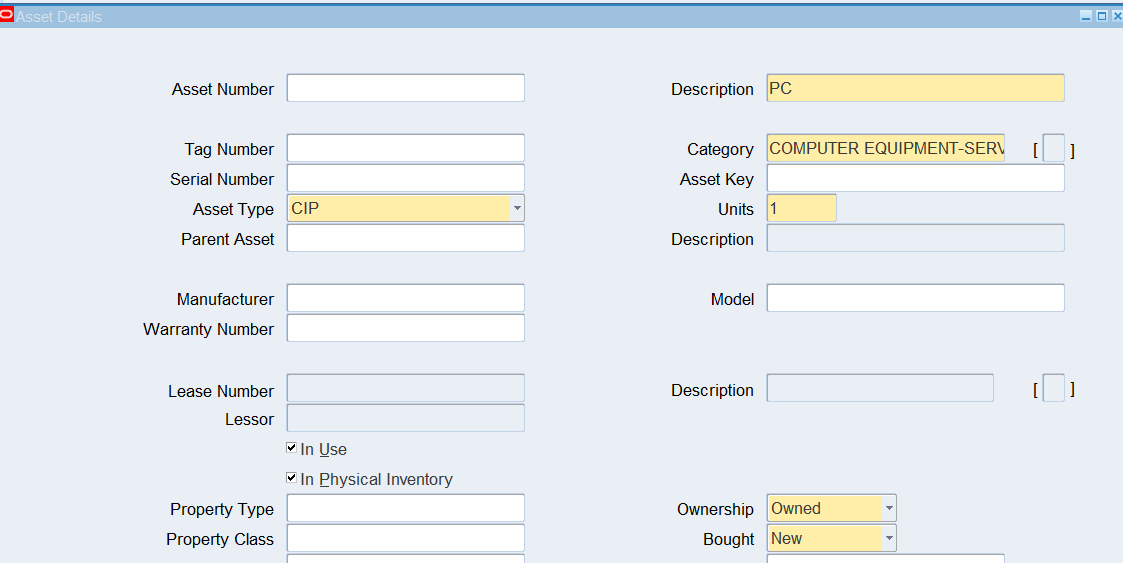
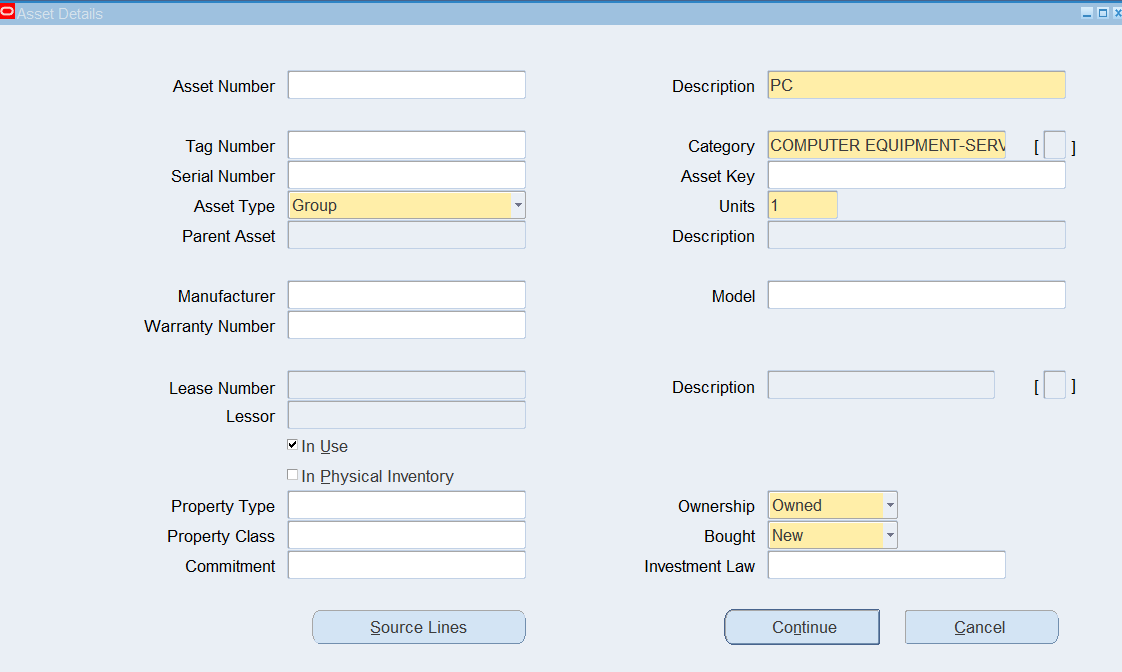
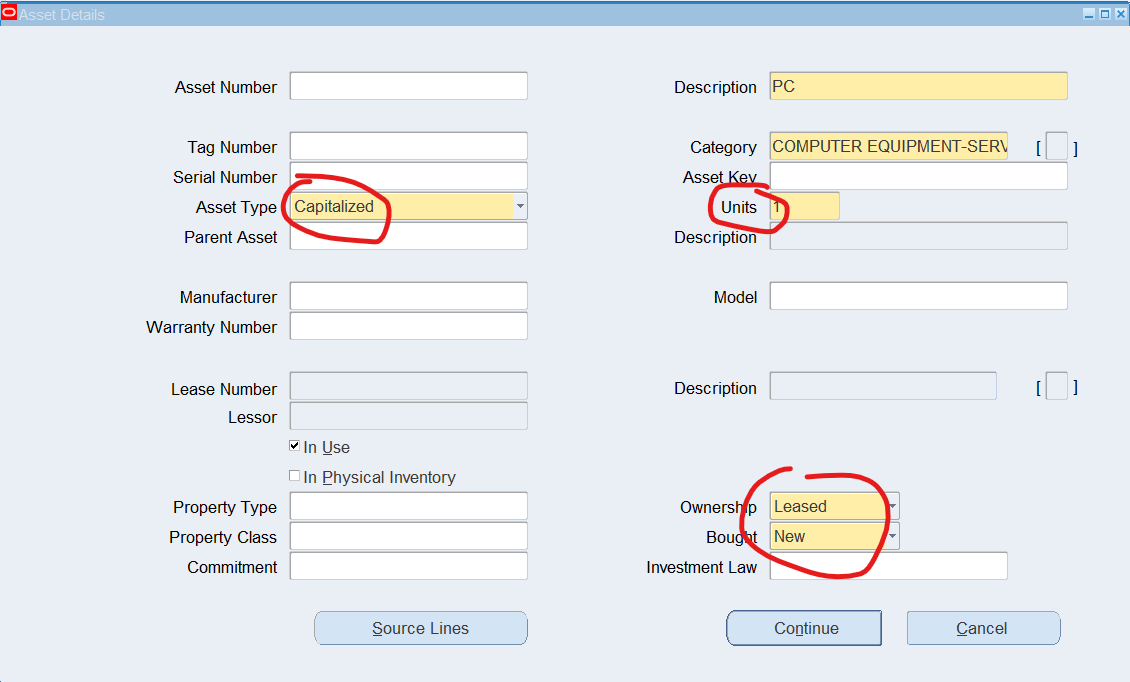
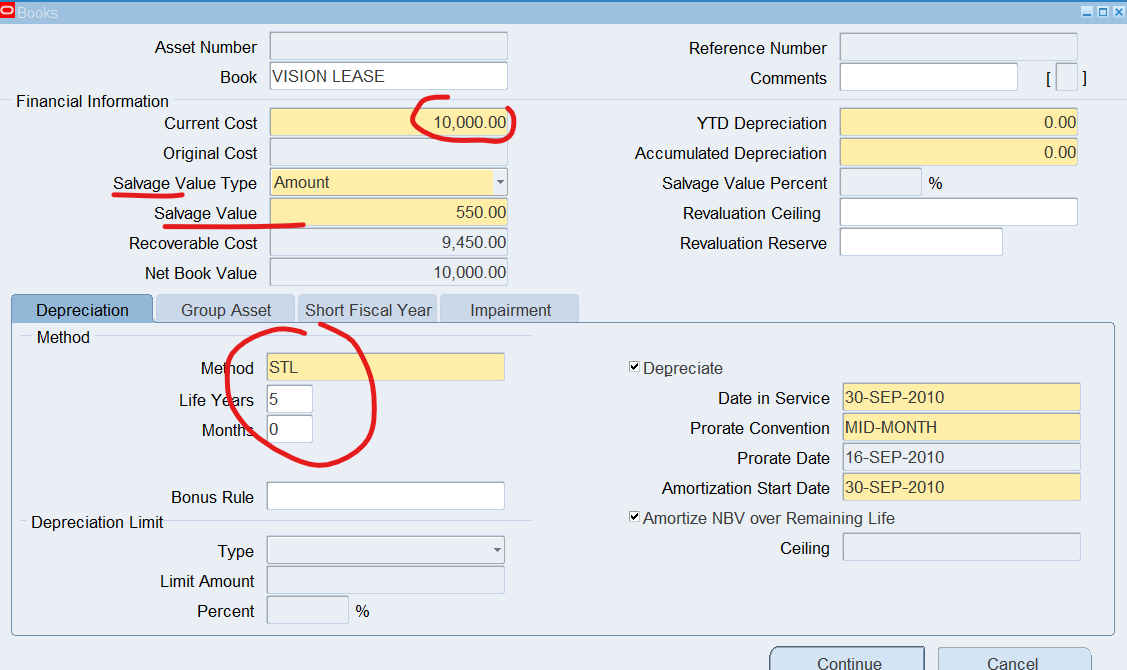

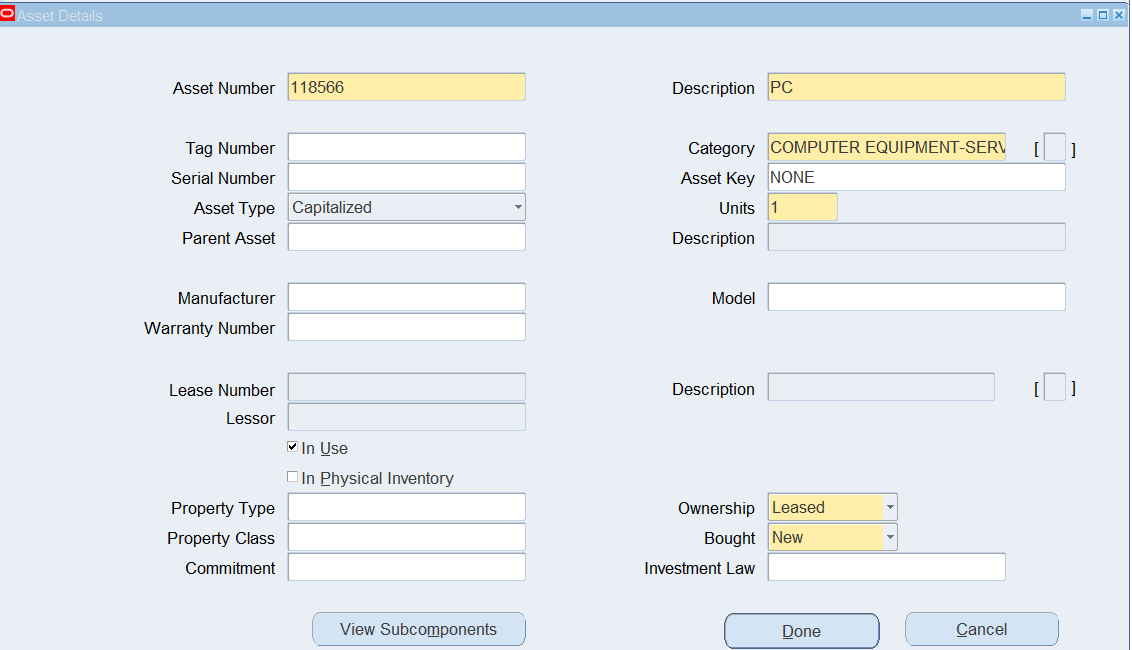
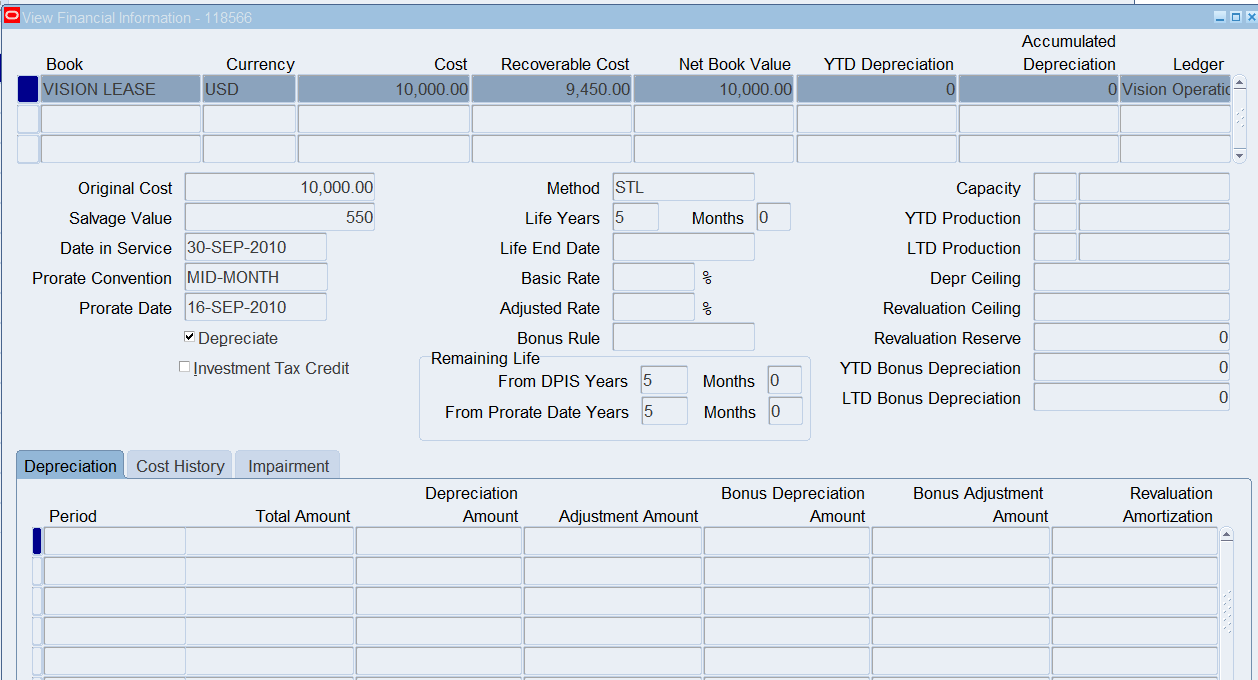
AP Invoices tracking Asset Books and Asset Number

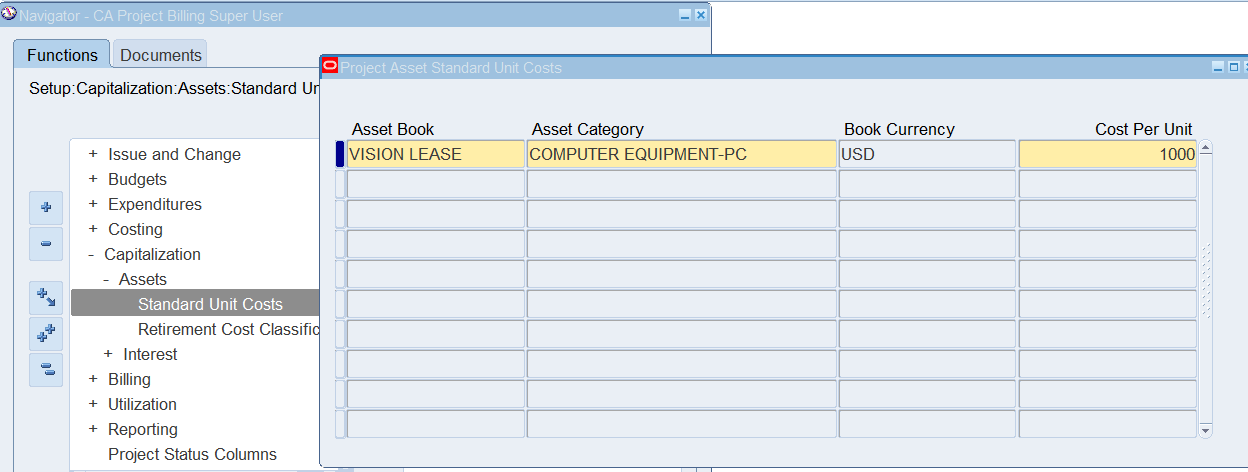
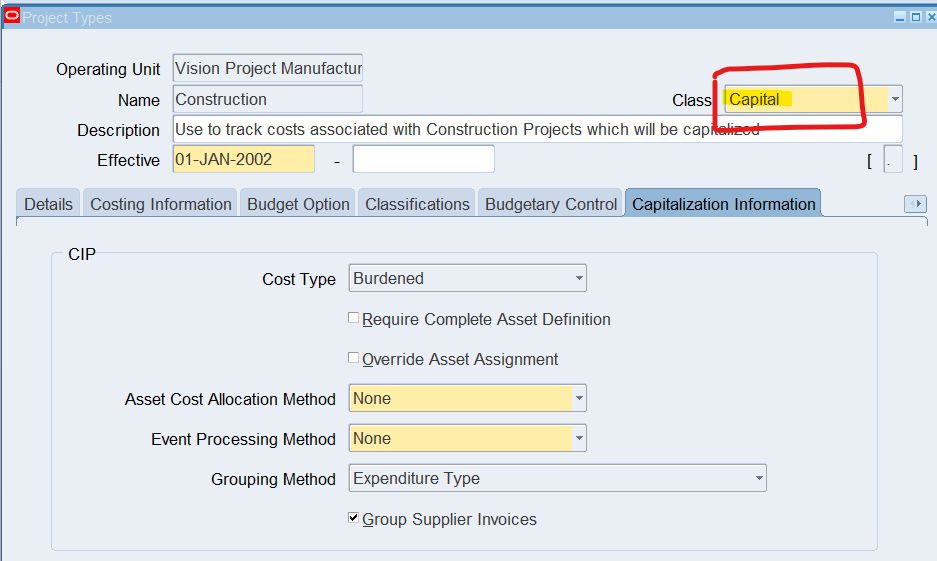

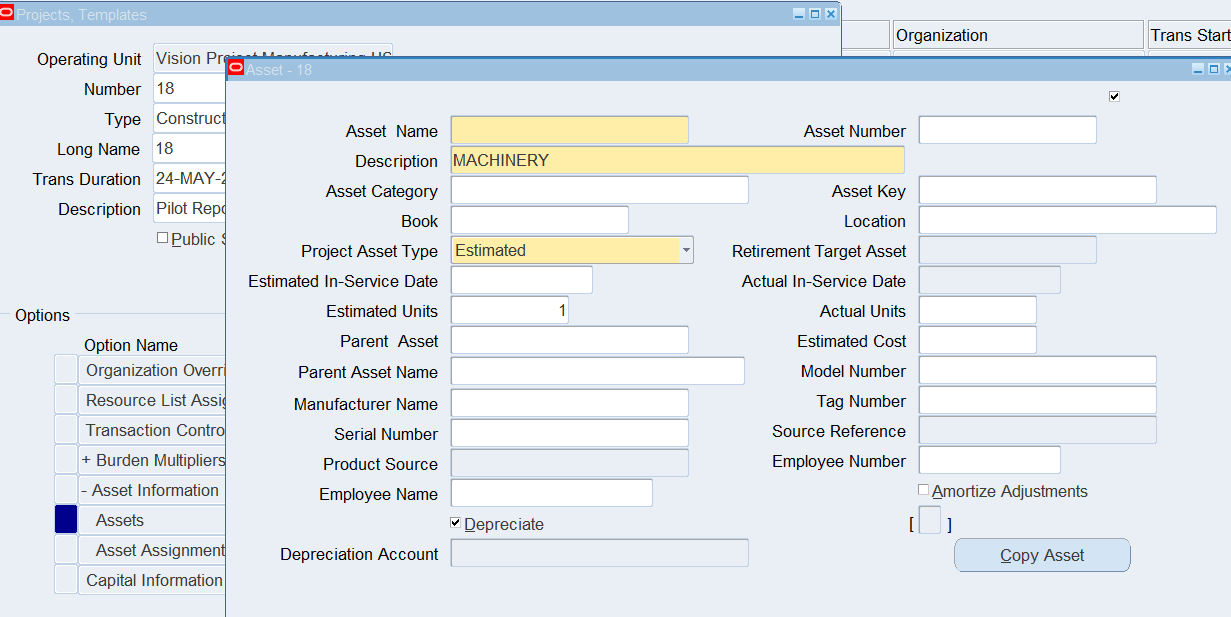
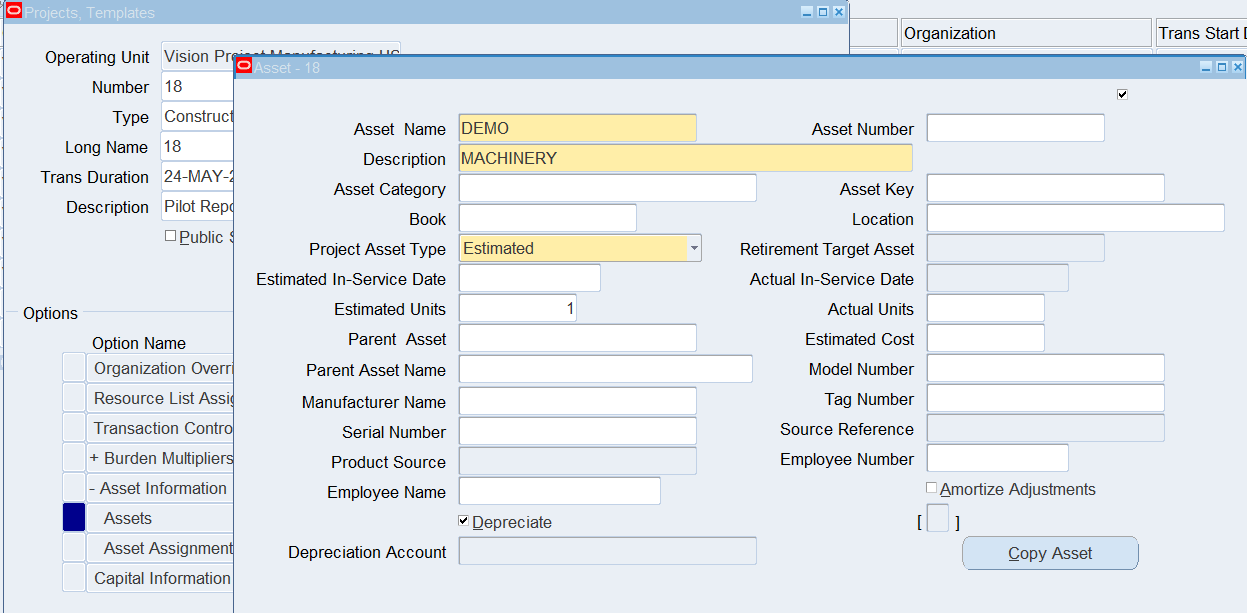
Demo Setup
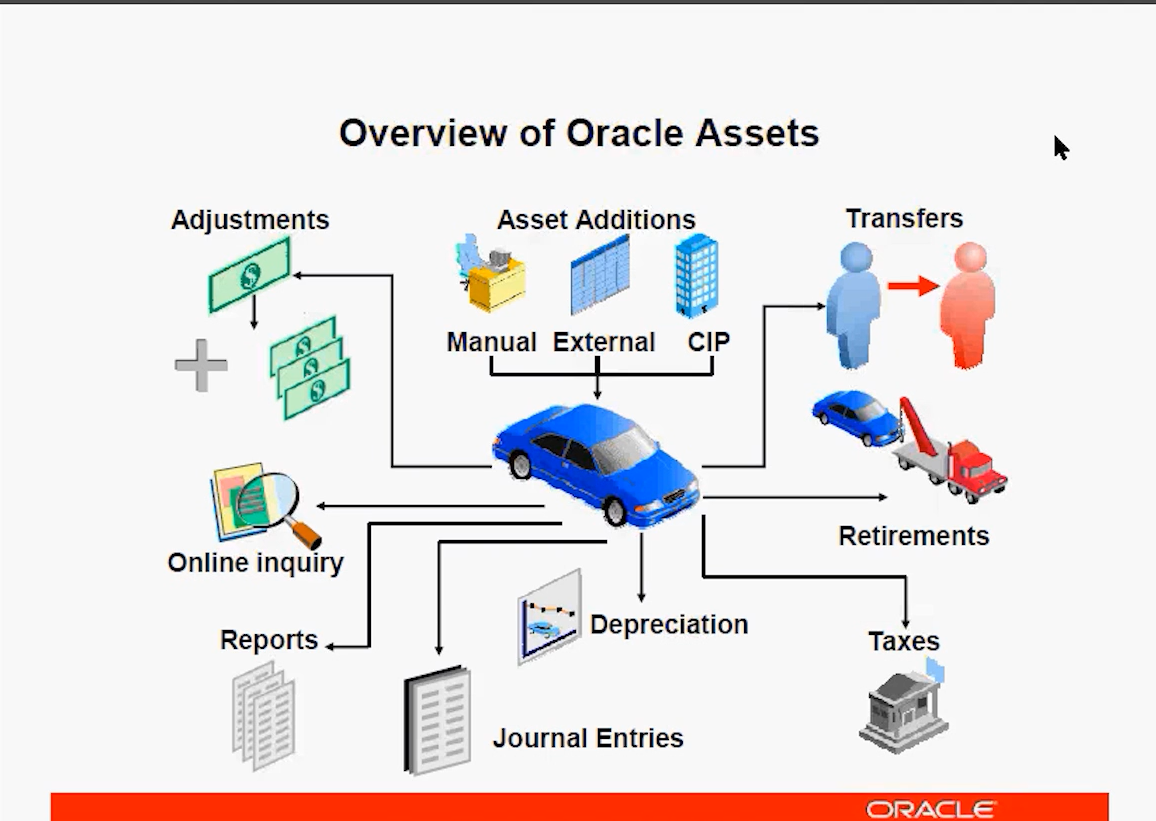
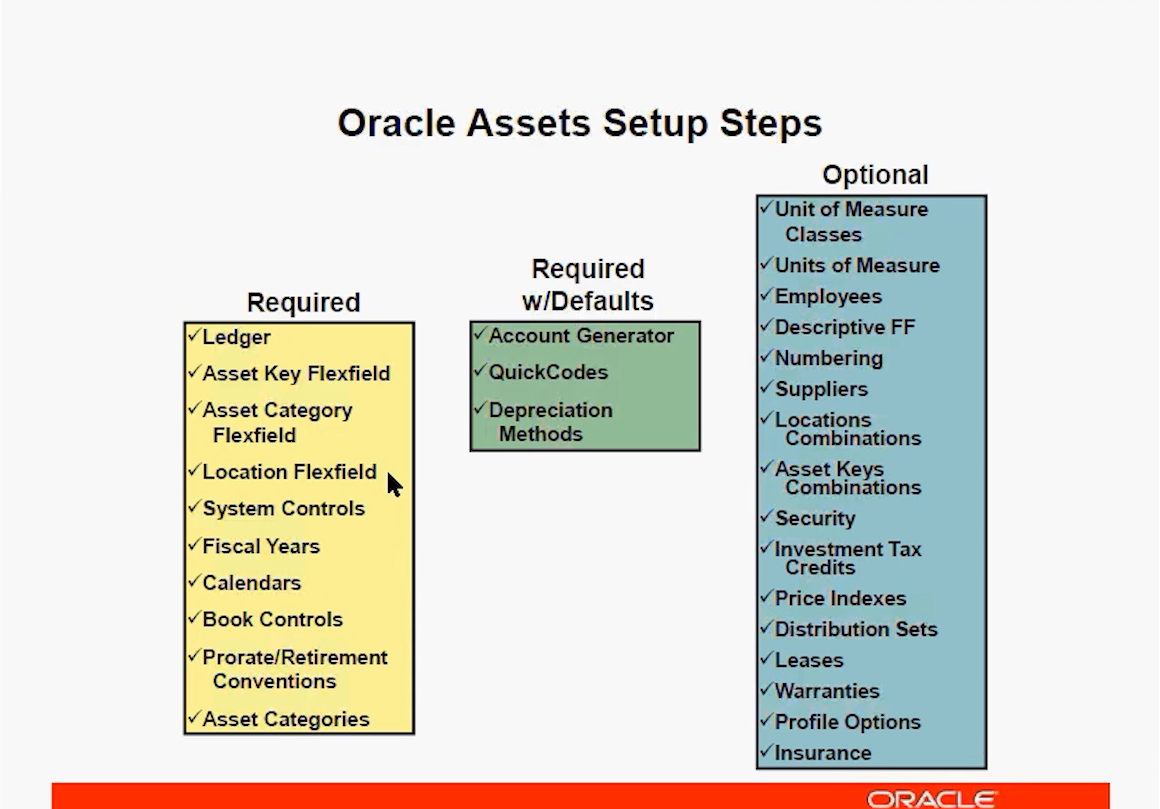
KEY FLEX FIELDS
- Key Flex Fields
- Descriptive Flex Field
Asset FlexFields
- Asset Category FlexField 🡪 Financial Impact Required
- Asset Location FledField 🡪 No Financial Impact Required
- Asset Key FlexField 🡪 No Financial Impact Optional
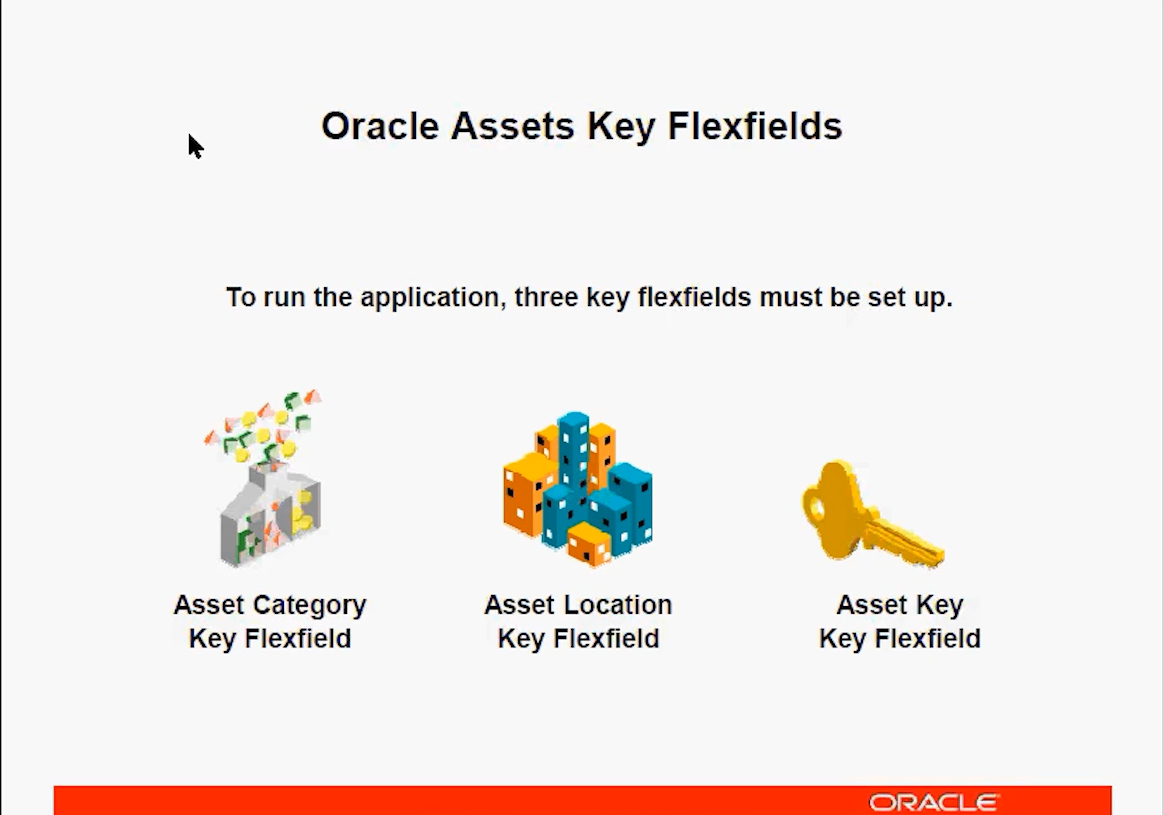
Books / Book Controls
General Ledger 🡪 Ledger
Fixed Assets 🡪 Books (Corp / Tax /Budget)
Calendar (Depreciation Calendar)
Prorate Conventions
Asset Types
- Capital Asset / Capitalized Asset
- Expensed Asset
- CIP Asset 🡪 Capitalize Asset